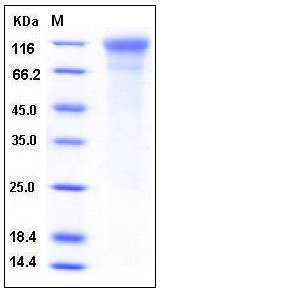Human CD50 / ICAM-3 Protein (His Tag)
CD50,CDW50,ICAM-R
- 100ug (NPP3703) Please inquiry
| Catalog Number | P10333-H08H |
|---|---|
| Organism Species | Human |
| Host | Human Cells |
| Synonyms | CD50,CDW50,ICAM-R |
| Molecular Weight | The recombinant human ICAM3 consists of 467 amino acids after removal of the signal peptide and predicts a molecular mass of 50.8 kDa. By SDS-PAGE, the apparent molecular mass of rh ICAM3 is approximately 100-120 kDa due to the glycosylation. |
| predicted N | Gln 30 |
| SDS-PAGE |  |
| Purity | > 92 % as determined by SDS-PAGE |
| Protein Construction | A DNA sequence encoding the extracellular domain of human ICAM3 (NP_002153.2) (Met 1-His 485) was expressed, with the C-terminal fused polyhistidine tag. |
| Bio-activity | Measured by the ability of the immobilized protein to support the adhesion of PMA-stimulated HSB2 human peripheral blood acute lymphoblastic leukemia cells. When cells are added to ICAM3-coated plates (12.5 μg/mL , 100 μL/well), approximately >25% cells will adhere specifically. |
| Research Area | Microbiology |Pathogenic microorganism |viruses |animal virus |Virus infection associated |Virus infection related | |
| Formulation | Lyophilized from sterile PBS, pH 7.5 1. Normally 5 % - 8 % trehalose, mannitol and 0.01% Tween80 are added as protectants before lyophilization. Specific concentrations are included in the hardcopy of COA. |
| Background | The protein ICAM-3, also known as CD50, is a member of the intercellular adhesion molecule (ICAM) family consisting three members. It is a DC-SIGN ligand that is constitutively expressed on resting leukocytes, and is thus an important molecule for the first immune response. ICAM-3 comprises of five immunoglobulin-like domains, and binds LFA-1 through its two N-terminal domains. It functions not only as an adhesion molecule, but also as a potent signalling molecule. ICAM-3 binds to LFA-1 on antigen-presenting cells (APC) stabilizing the T cell-APC interaction, facilitating signaling through the CD3/TCR complex. However, recent evidence using cultured and transformed T cells suggests ICAM-3 may also function in signaling. It has been reported that CD50 molecule can play a role in developing functionally mature T lymphocytes and its expression increases during the maturation process of T lymphocytes. In addition, the interactions of ICAM-3 and LFA-1 facilitate HIV-1- induced virological synapse formation between T cells. ICAM-3 is associated with an increase of cellular radio-resistance and cancer cell proliferation. It could be considered as a candidate for anti-cancer drug development and as a cancer diagnostic marker. |
| Reference |
